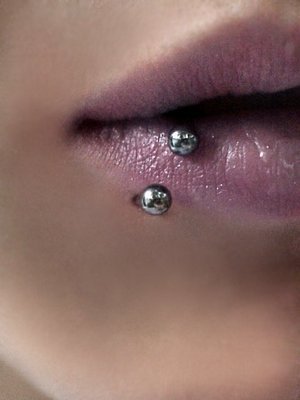


 HISTORY of piercing
HISTORY of piercing
Most people think that the piercing body parts, outside of the ears, is simply a new trend perpetuated by celebrities seeking new ways of flaunting their wealth and thumbing their noses at the mainstream population. However, they couldn’t be more wrong. Body piercing dates back thousands of years and has a rather rich tradition in various cultures throughout the world. Let’s take a look at some of the most popular piercing trends and explore the history behind each one of them.
Ear piercing
According to history, the oldest recorded mummy had pierced ears with large studs, which were likely in direct proportion to the gentleman’s wealth. That was a common practice within Egyptian nobility where both men and women pierced their ears. They generally wore elaborate, heavily enamelled and bejewelled earrings that were decorated with carvings representing nature or telling stories of family history.
Ear piercing is even mentioned in the Bible where body jewellery was considered a mark of beauty as well as wealth and status. It was common for such jewellery to be given as a bridal gift or even as part of the bride’s dowry. The Romans considered ear piercing a sign of nobility, wealth, and stature. Oddly enough, however, more Roman men took part in the practice then did women.
Sailors of the Elizabethan era pierced their ears for two reasons. First, they believed that piercing the ear would improve their long distance sight. Second, they generally chose large gold rings with sufficient value that could pay for their burial should death befall them. Men became very fashion-conscious during the Renaissance era and began sporting more jewellery. It was common for male nobility of the time to have at least one earring, often including gems such as pearls, diamonds, rubies, sapphires and the like.
But earrings were not limited to the European wealthy. Ear piercing was also common among many tribal peoples. In Africa people would stretch their ear-piercing holes to indicate their status within the tribe. The larger the hole, the higher the person in the hierarchy. Others believed that earrings had magical properties that prevented demons from entering their body through the ear. A few Native American tribes practised ear piercing as well, using bones and feathers for adornment.
In the West, the American Puritan movement almost completely did away with men wearing earrings there until the late 60’s. The European influence, however, kept the practice alive in and is credited with finally making pierced ears a mainstream practice. The revival began in the 1920’s and slowly built up over the next four decades, finally reaching its height of popularity in the late 60’s and early 70’s. Nowadays, pierced ears are almost the norm for men in some parts of Western society.
Lip piercing
The Aztecs and Mayans often wore labrets which refers to abret is any type of adornment that is attached to the facial lip or gold and semi-precious stones like jade or obsidian in to distinguish themselves as nobility or societal members of a higher social standing. These were often elaborately carved with religious figures or heavily encrusted with gemstones.
Tribes of Africa and Central America have practised lip piercing for hundreds of years. The women of some tribes wear labret plates in their upper lips because they believe that this enhances their beauty and entices men. In some instances, the type of labret worn symbolises whether or not a woman is available or already betrothed. The plates are typically made of wood, ivory, abalone shell, bones or precious metals like gold. They are sometimes over-stretched.
A few Native American tribes, like those of the Pacific Northwest, as well as the Inuit people of Alaska, wore labrets fashioned from walrus ivory, abalone shell, bone, obsidian, and wood. Although practised by some, lip piercing has not yet become mainstream in the West.
Navel piercing
Once again, it was the Egyptians who started this trend, which was restricted for use by the pharaoh alone. Anyone else practicing it would be executed. It was believed that navel piercing represented courage and virility. Navel piercing in western civilization is still relatively new. The invention of the bikini allowed women to begin flaunting their sexuality in public, paving the way for more bare midriffs and appropriate jewellery adornment. But it wasn’t until models Christy Turlington and Naomi Campbell sported their navel rings on the catwalk that the practice of navel piercing became popular. Celebrities like Cher and Madonna quickly followed suit and before long, the practice was moving mainstream.
Nipple piercing
The Romans may have been the first culture to make this type of piercing popular, although the Egyptians also practised it. Roman centurions pierced their nipples to demonstrate their dedication to the Empire. It was also a badge of courage meant to show their strength and virility.
Women of the Renaissance period turned the practice feminine. Plunging necklines, some so low that very little above the waist was covered, gave women a chance to sport jewelry in pierced and rouged nipples. The next resurgence of interest in nipple piercing was, of all things, during the Victorian age. In fact, by the 1890’s, a lot of European women had their nipples pierced. Some even connected the rings in each nipple with a fine, delicate chain.
Nipple piercing was even practised by some early Native American tribes, although it was not common. Nipple piercing has only recently experienced a minor resurgence. A lot of celebrities take part in the practice; in particular musicians like Tommy Lee and Axl Rose.
Tongue piercing
Both Aztec and Mayan priests practised tongue piercing as part of their religious rituals. It was believed that by piercing their tongues, they opened a method of communication to their gods. Tongue piercing today is still considered one of the most provocative types of piercing because of its sheer shock value. It is not yet a mainstream practice but one that is certainly growing in popularity.
Nose/Nostril piercing
Oddly enough, this form of piercing also dates back several thousand years; it is referred to in the Old Testament Book of Genesis. Nostril piercing is believed to have originated in the Middle East some 5,000 years ago, and is still practised by many nomadic tribes. Husbands of the Bedouin, Berber, and Beja tribes present their wives with a nose ring at their wedding, the size of the ring denoting the family’s wealth and stature. The ring also becomes the woman’s security should her husband opt to divorce her.
This marriage practice was also found in India from the 17th century. Indian women traditionally pierced their left nostril and wore their stud ring there because that spot is associated with the female reproductive system. Indian women believed that piercing would lessen monthly period pain as well as ease the pain typically associated with childbirth. Sometimes the nostril ring is joined to a pierced ear with a chain.
The Indian practice was brought back to America by the hippie generation that had visited the country in search of spiritual enlightenment. It soon took on a new meaning — that of rebellion against the mainstream. Young people took delight in the fact that their conservative parents hated the piercing. Punk rockers picked up the practice in the 70’s and made it their own form of rebellion — basically against mankind as a whole. Slowly but surely, however, nose piercing has begun to become socially acceptable throughout the world, particularly when it is done with taste.
The modern world
The interest in body piercing as a whole really caught on in the West in the late 80’s and 90’s. At first only celebrities sported the more avant guarde styles, but before long, they caught on with impressionable teens and youth-conscious moms. And no doubt this ancient form of body art will continue to grow in popularity. — the beautybiz.com